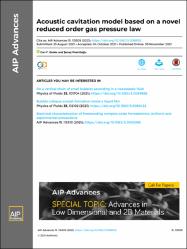Please use this identifier to cite or link to this item:
https://hdl.handle.net/20.500.11779/1587Full metadata record
| DC Field | Value | Language |
|---|---|---|
| dc.contributor.author | Pasinlioğlu, Şenay | - |
| dc.contributor.author | Delale, Can Fuad | - |
| dc.date.accessioned | 2021-11-25T09:39:28Z | |
| dc.date.available | 2021-11-25T09:39:28Z | |
| dc.date.issued | 2021 | - |
| dc.identifier.citation | Delale, C. F., & Pasinlioğlu, Ş. (04 October 2021 ). Acoustic cavitation model based on a novel reduced order gas pressure law. AIP Advances, 11(11), pp. 1-24. https://doi.org/10.1063/5.0068152 | en_US |
| dc.identifier.issn | 2158-3226 | - |
| dc.identifier.uri | https://hdl.handle.net/20.500.11779/1587 | - |
| dc.identifier.uri | https://doi.org/10.1063/5.0068152 | - |
| dc.description.abstract | The thermal behavior of a spherical gas bubble in a liquid excited by an acoustic pressure signal is investigated by constructing an iterative solution of the energy balance equations between the gas bubble and the surrounding liquid in the uniform pressure approximation. This iterative solution leads to hierarchy equations for the radial partial derivatives of the temperature at the bubble wall, which control the temporal rate of change of the gas pressure and gas temperature within the bubble. In particular, a closure relation for the hierarchy equations is introduced based on the ansatz that approximates the rapid change of state during the collapse of the bubble from almost isothermal to almost adiabatic behavior by time averaging the complex dynamics of change of state over a relatively short characteristic time. This, in turn, leads to the desired reduced order gas pressure law exhibiting power law dependence on the bubble wall temperature and on the bubble radius, with the polytropic index depending on the isentropic exponent of the gas and on a parameter that is a function of the Péclet number and a characteristic time scale. Results of the linear theory for gas bubbles are recovered by identifying this parameter as a function of the Péclet number based on the Minnaert frequency. The novel gas pressure law is then validated against the near-isothermal solution and against the results of the numerical simulations of the original energy balance equations for large amplitude oscillations using spectral methods. Consequently, an acoustic cavitation model that accounts for phase change but that neglects mass diffusion is constructed by employing the reduced order gas pressure law together with the Plesset–Zwick solution for the bubble wall temperature and the Keller–Miksis equation for spherical bubble dynamics. Results obtained using variable interface properties for acoustically driven cavitation bubbles in water show that the time variations of the bubble radius and the bubble wall temperature lie between those obtained by the isothermal and adiabatic laws depending on the value of the Péclet number and the characteristic time scale. | en_US |
| dc.language.iso | en | en_US |
| dc.rights | info:eu-repo/semantics/openAccess | en_US |
| dc.subject | Air buubleles | en_US |
| dc.subject | Oscillations | en_US |
| dc.subject | Thermal behavior | en_US |
| dc.subject | Vapor | en_US |
| dc.subject | Bubble dynamics | en_US |
| dc.title | Acoustic Cavitation Model Based on a Novel Reduced Order Gas Pressure Law | en_US |
| dc.type | Article | en_US |
| dc.identifier.doi | 10.1063/5.0068152 | - |
| dc.identifier.scopus | 2-s2.0-85118769383 | - |
| dc.authorid | Can Fuat Delale / 0000-0002-4577-9201 | - |
| dc.description.PublishedMonth | Kasım | en_US |
| dc.description.woscitationindex | Science Citation Index Expanded | en_US |
| dc.identifier.wosquality | Q4 | - |
| dc.description.WoSDocumentType | Article | - |
| dc.description.WoSInternationalCollaboration | Uluslararası işbirliği ile yapılmayan - HAYIR | en_US |
| dc.description.WoSPublishedMonth | November | en_US |
| dc.description.WoSIndexDate | 2021 | en_US |
| dc.description.WoSYOKperiod | YÖK - 2021-22 | en_US |
| dc.identifier.scopusquality | Q2 | - |
| dc.relation.publicationcategory | Makale - Uluslararası Hakemli Dergi - Kurum Öğretim Elemanı | en_US |
| dc.identifier.startpage | 1-24 | en_US |
| dc.identifier.issue | 11 | en_US |
| dc.identifier.volume | 11 | en_US |
| dc.department | Mühendislik Fakültesi, Makine Mühendisliği Bölümü | en_US |
| dc.relation.journal | AIP Advances | en_US |
| dc.identifier.wos | WOS:000716755400013 | - |
| dc.institutionauthor | Delale, Can Fuad | - |
| item.grantfulltext | open | - |
| item.languageiso639-1 | en | - |
| item.openairetype | Article | - |
| item.cerifentitytype | Publications | - |
| item.fulltext | With Fulltext | - |
| item.openairecristype | http://purl.org/coar/resource_type/c_18cf | - |
| crisitem.author.dept | 02.03. Department of Mechanical Engineering | - |
| Appears in Collections: | Makine Mühendisliği Bölümü Koleksiyonu Scopus İndeksli Yayınlar Koleksiyonu / Scopus Indexed Publications Collection WoS İndeksli Yayınlar Koleksiyonu / WoS Indexed Publications Collection | |
Files in This Item:
| File | Description | Size | Format | |
|---|---|---|---|---|
| Delale-2021-Acoustic-cavitation-model-based-on-.pdf | Full Text - Article | 7.8 MB | Adobe PDF |  View/Open |
CORE Recommender
Sorry the service is unavailable at the moment. Please try again later.
Items in GCRIS Repository are protected by copyright, with all rights reserved, unless otherwise indicated.